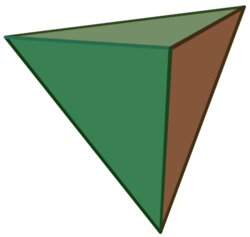Simplicial link

In a simplicial complex, the link of a vertex v is the collection of subsets of vertices such that, if they are added to v, the result is a simplex. As an example, suppose v is the top vertex of the tetrahedron at the left. Then the link of v is the triangle at the base of the tetrahedron. This is because, for each edge of that triangle, if the edge is added to v, the result is a triangle (one of the three triangles at the sides of the tetrahedron).
The link of a vertex encodes information about the local structure of the complex at the vertex. It is a graph-theoretic analog to a sphere centered at a point.
Definition
Let X be a simplicial complex. The link of a vertex v is the graph Lk(v, X) constructed as follows. The vertices of Lk(v, X) are precisely the edges of X incident to v. Two such edges are adjacent in Lk(v, X) iff they are incident to a common 2-cell at v.
The graph Lk(v, X) is often given the topology of a ball of small radius centred at v.
Similarly, for an abstract simplicial complex and a face F of X, there is also a notion of the link of a face F, denoted Lk(F, X). Lk(F, X) is the set of faces G such that
- [math]\displaystyle{ G\cap F=\emptyset\text{ and }G\cup F\in X }[/math].
Because X is simplicial, there is a set isomorphism between Lk(F, X) and
- [math]\displaystyle{ X_F = \{G \in X\text{ such that }F \subset G\} }[/math].
Examples
The link of a vertex of a tetrahedron is a triangle – the three vertices of the link corresponds to the three edges incident to the vertex, and the three edges of the link correspond to the faces incident to the vertex. In this example, the link can be visualized by cutting off the vertex with a plane; formally, intersecting the tetrahedron with a plane near the vertex – the resulting cross-section is the link.
Another example is illustrated below.
See also
- Vertex figure - a geometric concept similar to the simplicial link.
References
- Bridson, Martin; Haefliger, André (1999), Metric spaces of non-positive curvature, Springer, ISBN 3-540-64324-9



